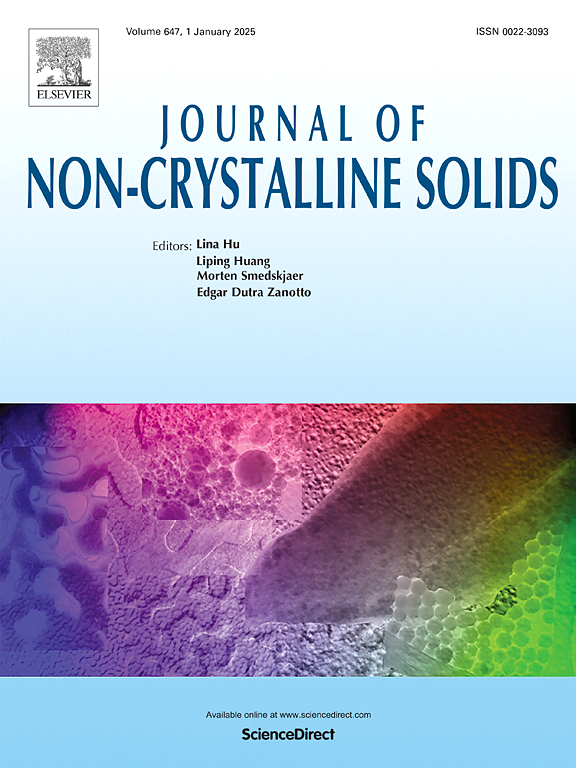考古玻璃在埋葬条件下的改变:来自中国青海出土的绿松石玻璃珠的证据
IF 3.5
3区 材料科学
Q1 MATERIALS SCIENCE, CERAMICS
引用次数: 0
摘要
考古玻璃在土壤中长期埋藏后呈现出复杂的蚀变现象,为研究水环境中的玻璃蚀变提供了重要的见解。作为重要装饰品的玻璃珠可追溯至8世纪中期,出土于中国青海省。然而,这些玻璃珠在土壤中埋藏了大约1300年,导致状态不佳。通过对各种玻璃微珠的观察,选取了4片绿松石玻璃微珠,研究了蚀变层的形态结构特征和化学成分。几种科学技术,包括光学显微镜(OM)、配备能量色散x射线光谱(SEM-EDS)的扫描电子显微镜和微拉曼光谱,被用于分析。结果表明,原始玻璃主要由钠钙硅酸盐玻璃(NaOCaO-SiO2)构成,极易受风化作用。原始玻璃转变为白色蚀变层,由层状蚀变层和均匀脱碱性层组成。层状亚层的厚度范围为0.1 ~ 5 μm,主要由球形二氧化硅颗粒和少量富铝凝胶组成。少量富al凝胶析出的无定形二氧化硅在浓度差异的影响下形成具有明暗交替特征的层状结构。在脆性玻璃内部,随着富硅蚀变层沿着裂纹网络逐渐取代基体,其外观和整体强度都发生了显著变化。本文章由计算机程序翻译,如有差异,请以英文原文为准。
Archaeological glass altered under burial conditions: Evidence from turquoise glass beads excavated from Qinghai, China
Archaeological glasses present complex alteration phenomena after long-term burial in soil, providing crucial insights into glass alteration in aqueous environments. The glass beads as important decorations were dating back to mid-8th century, excavated from Qinghai province, China. However, these glass beads have been buried in soil for approximately 1300 years and resulting in a poor state. After observation of various glass beads, four pieces from the turquoise glass beads are selected to study the morphological structural features and chemistry compositional of the alteration layer. Several scientific techniques, including optical microscopy (OM), scanning electron microscopy equipped with energy dispersive X-ray spectrometry (SEM–EDS), and micro-Raman spectroscopy, are employed for analysis. The results show that pristine glasses are made of soda-lime silicate glass (NaO![]() CaO-SiO2), which are highly susceptible to weathering. The pristine glass transformed into a white alteration layer, which consists of laminated alteration layers and homogeneous dealkalized layer. The laminated sub-layers, with thicknesses ranging from 0.1 to 5 μm, are characterized by spherical silica particles and a minor Al-rich gel. The precipitation of amorphous silica with minor Al-rich gel forms a laminated structure with alternating light and dark features influenced by concentration differences. Inside the brittle glass, as the silica-rich alteration layers gradually replace the matrix along the network of cracks, both its appearance and overall strength are significantly altered.
CaO-SiO2), which are highly susceptible to weathering. The pristine glass transformed into a white alteration layer, which consists of laminated alteration layers and homogeneous dealkalized layer. The laminated sub-layers, with thicknesses ranging from 0.1 to 5 μm, are characterized by spherical silica particles and a minor Al-rich gel. The precipitation of amorphous silica with minor Al-rich gel forms a laminated structure with alternating light and dark features influenced by concentration differences. Inside the brittle glass, as the silica-rich alteration layers gradually replace the matrix along the network of cracks, both its appearance and overall strength are significantly altered.
求助全文
通过发布文献求助,成功后即可免费获取论文全文。
去求助
来源期刊

Journal of Non-crystalline Solids
工程技术-材料科学:硅酸盐
CiteScore
6.50
自引率
11.40%
发文量
576
审稿时长
35 days
期刊介绍:
The Journal of Non-Crystalline Solids publishes review articles, research papers, and Letters to the Editor on amorphous and glassy materials, including inorganic, organic, polymeric, hybrid and metallic systems. Papers on partially glassy materials, such as glass-ceramics and glass-matrix composites, and papers involving the liquid state are also included in so far as the properties of the liquid are relevant for the formation of the solid.
In all cases the papers must demonstrate both novelty and importance to the field, by way of significant advances in understanding or application of non-crystalline solids; in the case of Letters, a compelling case must also be made for expedited handling.
 求助内容:
求助内容: 应助结果提醒方式:
应助结果提醒方式:


